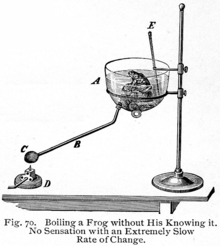Boiling frog

The boiling frog story is a widespread anecdote describing a frog slowly being boiled alive. The premise is that if a frog is placed in boiling water, it will jump out, but if it is placed in cold water that is slowly heated, it will not perceive the danger and will be cooked to death. The story is often used as a metaphor for the inability or unwillingness of people to react to significant changes that occur gradually, such as creeping state surveillance.[1]
According to contemporary biologists the premise of the story is not literally true; a frog submerged and gradually heated will jump out.[2][3] However, some 19th-century experiments suggested that the underlying premise is true, provided the heating is sufficiently gradual.[4][5]
The story's common metaphorical use is a caution for people to be aware of even gradual change lest they suffer eventual undesirable consequences.
The science

As part of advancing science, several experiments observing the reaction of frogs to slowly heated water took place in the 19th century. In 1869, while doing experiments searching for the location of the soul, German physiologist Friedrich Goltz demonstrated that a frog that has had its brain removed will remain in slowly heated water, but an intact frog attempted to escape the water when it reached 25 °C.[4][6]
Other experiments showed that frogs did not attempt to escape gradually heated water. An 1872 experiment by Heinzmann demonstrated that a normal frog would not attempt to escape if the water was heated slowly enough,[7] which was corroborated in 1875 by Fratscher.[8]
Goltz raised the temperature of the water from 17.5 °C to 56 °C in about ten minutes, or 3.8 °C per minute, in his experiment which prompted normal frogs to attempt to escape, whereas Heinzmann heated the frogs over the course of 90 minutes from about 21 °C to 37.5 °C, a rate of less than 0.2 °C per minute.[4] In "On the Variation of Reflex Excitability in the Frog induced by changes of Temperature" (1882) William Thompson Sedgwick writes: "in one experiment by Scripture the temperature was raised at a rate of 0.002°C per second, and the frog was found dead at the end of 2½ hours without having moved."[9]
In 1888 Sedgwick explained the apparent contradiction between the results of these experiments as a consequence of different heating rates used in the experiments: "The truth appears to be that if the heating be sufficiently gradual, no reflex movements will be produced even in the normal frog; if it be more rapid, yet take place at such a rate as to be fairly called 'gradual', it will not secure the repose of the normal frog under any circumstances".[5]
Modern sources tend to dispute that the phenomenon is real. In 1995, Professor Douglas Melton, of the Harvard University Biology department, said, "If you put a frog in boiling water, it won't jump out. It will die. If you put it in cold water, it will jump before it gets hot—they don't sit still for you." Dr. George R. Zug, curator of reptiles and amphibians at the National Museum of Natural History, also rejected the suggestion, saying that "If a frog had a means of getting out, it certainly would get out."[2]
In 2002 Dr. Victor H. Hutchison, Professor Emeritus of Zoology at the University of Oklahoma, with a research interest in thermal relations of amphibians, said that "The legend is entirely incorrect!". He described how the critical thermal maximum for many frog species has been determined by contemporary research experiments: as the water is heated by about 2 °F, or 1.1 °C, per minute, the frog becomes increasingly active as it tries to escape, and eventually jumps out if the container allows it.[3][10]
None of these modern rebuttals – Melton, Zug, or Hutchison's – attempts to replicate an extremely slow-heating experiment as cited by Goltz or Scripture: only Hutchison did a thermal trial at over five times Goltz's slow rate and over nine times Scripture's 0.002 °C per second temperature rise.
Use
As metaphor
If you drop a frog in a pot of boiling water, it will of course frantically try to clamber out. But if you place it gently in a pot of tepid water and turn the heat on low, it will float there quite placidly. As the water gradually heats up, the frog will sink into a tranquil stupor, exactly like one of us in a hot bath, and before long, with a smile on its face, it will unresistingly allow itself to be boiled to death.
The boiling frog story is generally offered as a metaphor cautioning people to be aware of even gradual change lest they suffer eventual undesirable consequences. It may be invoked in support of a slippery slope argument as a caution against creeping normality. It is also used in business to reinforce that change needs to be gradual to be accepted.[1][11] Oppositely, the expression "boiling frog syndrome" is sometimes used as shorthand to invoke the pitfalls of standing pat.[12]
The story has been retold many times and used to illustrate widely varying viewpoints. Among them: in 1960 about sympathy towards the Soviet Union during the Cold War;[13] in 1980 about the impending collapse of civilization anticipated by survivalists;[14] in the 1990s about inaction in response to climate change and staying in abusive relationships.[15][16] It has also been used by libertarians to warn about slow erosion of civil rights.[11]
In the 1996 novel The Story of B, environmentalist author Daniel Quinn spends a chapter on the metaphor of the boiling frog, using it to describe human history, population growth and food surplus.[17] Pierce Brosnan's character Harry Dalton mentioned it in the 1997 disaster movie Dante's Peak in reference to the accumulating warning signs of the volcano's reawakening.[18] Al Gore used a version of the story in his presentations and the 2006 movie An Inconvenient Truth to describe ignorance about global warming. In his version the frog is rescued before it is harmed.[19] This use of the story was referenced ironically by writer/director Jon Cooksey in the title of his 2010 comedic documentary How to Boil a Frog.[20]
Law professor and legal commentator Eugene Volokh commented in 2003 that regardless of the behavior of real frogs, the boiling frog story is useful as a metaphor, comparing it to the metaphor of an ostrich with its head in the sand.[11] Economics Nobel laureate and New York Times op-ed writer Paul Krugman used the story as a metaphor in a July 2009 column, while pointing out that real frogs behave differently.[21] Journalist James Fallows has been advocating since 2006 for people to stop retelling the story, describing it as a "stupid canard" and a "myth".[22][23] But following Krugman's column, he declared "peace on the boiled frog front" and said that using the story is fine as long as you point out it's not literally true.[24]
In philosophy
In philosophy the boiling frog story has been used as a way of explaining the sorites paradox. It describes a hypothetical heap of sand from which individual grains are removed one at a time, and asks if there is a specific point when it can no longer be defined as a heap.[25]
See also
- "Boiled Frogs", a song by Alexisonfire
- Camel's Nose, a story with similar meaning
- Continuum fallacy
- Creeping normality
- First they came ...
- Frogs in popular culture
- Shifting baseline
- Slippery slope
- Sorites Paradox
References
- ↑ 1.0 1.1 "Slow Boiled Frog". Snopes. Retrieved 2009-06-02
- ↑ 2.0 2.1 "Next Time, What Say We Boil a Consultant". Fast Company Issue 01. October 1995. Retrieved 2006-03-10
- ↑ 3.0 3.1 "The legend of the boiling frog is just a legend" by Whit Gibbons, Ecoviews, November 18, 2002, retrieved January 6, 2008
- ↑ 4.0 4.1 4.2 Offerman 2010
- ↑ 5.0 5.1 Sedgwick 1888, p. 399
- ↑ James Fallows (21 July 2009). "Guest-post wisdom on frogs". The Atlantic. Retrieved 2009-07-22
- ↑ Sedgwick 1888, p. 390
- ↑ Sedgwick 1888, p. 394
- ↑ Edward Scripture, The New Psychology (1897): . The original 1872 experiment was cited in: Sedgwick, "On the Variation of Reflex Excitability in the Frog induced by changes of Temperature," Stud. Biol. Lab. Johns Hopkins University (1882): 385. "in one experiment the temperature was raised at a rate of 0.002 °C. per second, and the frog was found dead at the end of 2½ hours without having moved."
- ↑ "Victor H. Hutchison - Department of Zoology, University of Oklahoma". Retrieved 2009-06-24
- ↑ 11.0 11.1 11.2 Volokh, Eugene (2003). "The Mechanisms of the Slippery Slope". Harvard Law Review 116 (4): 1026–1137. doi:10.2307/1342743. JSTOR 1342743.
- ↑ David Bolchover (March 26, 2005). "What is ... 'boiling frog syndrome'?". The Times. London
- ↑ Trohan, Walter (6 June 1960). "Report from Washington". Chicago Tribune. p. 2.
The frog dropped into boiling water has sense to leap out, but the frog dropped into cold water can be cooked to death before he realizes he is in serious trouble. So it is with us Americans and our civilization in this mounting crisis. We must beware of those who want to thaw the cold war out at any cost. We may be cooked before we realize what has happened.
- ↑ Quoted in Recchia, Cammille (25 August 1980). "Area Survivalists Circle Wagons for Coming Armageddon; Survivalists Prepare to Ride Out Armageddon; Fearing Economic Chaos, Advocates Store Food, Buy Gold, Silver". Washington Post. p. C1.
That's what's happening to us. Things are getting worse and worse, so we don't really notice what's happening. Whatever happens will happen slowly, and we won't have time to jump out.
- ↑ Tickell, Crispin (1990). "Human Effects of Climate Change: Excerpts from a Lecture Given to the Society on 26 March 1990". The Geographical Journal 156 (3): 325–329 [p. 325]. doi:10.2307/635534.
This is not an experiment I wish to commend, but it has lessons for another animal—ourselves. If drastic change takes place abruptly, we notice and react to it. If it takes place gradually, over a few generations, we are hardly aware of it, and by the time that we are ready to react, it can be too late.
- ↑ Evans, Patricia (1996). The Verbally Abusive Relationship: How To Recognize it and How to Respond. Holbrook, MA: Adams Media. p. 111. ISBN 1-55850-582-2.
We are not inclined to notice gradual changes. This is how most partners adapt to verbal abuse. They slowly adapt until, like frog number two, they are living in an environment which is killing to their spirit.
- ↑ Quinn, Daniel (1996). "The Boiling Frog". The Story of B. ISBN 0-553-37901-1
- ↑ Pierce Brosnan (Star), Roger Donaldson (Director), Leslie Bohem (Writer) (1997). Dante's Peak (Motion picture). USA.
- ↑ Al Gore (Writer), Davis Guggenheim (Director) (2006). An Inconvenient Truth (Motion picture). USA.
- ↑ Jon Cooksey (Writer/director) (2010). How to Boil a Frog (Motion picture). Canada.
- ↑ Krugman, Paul (2009-07-13). "Boiling the Frog". The New York Times. Retrieved 2010-04-26.
- ↑ Fallows, James (13 March 2007). "The boiled-frog myth: stop the lying now!". The Atlantic. Retrieved 2009-06-27.
- ↑ Fallows, James (16 September 2006). "The boiled-frog myth: hey, really, knock it off!". The Atlantic. Retrieved 2009-06-24.
- ↑ Fallows, James (July 13, 2009). "Peace on the boiled frog front". The Atlantic.
- ↑ Goldstein, Laurence (2000). "How to boil a live frog". Analysis 60 (266): 170–178. doi:10.1111/1467-8284.00220.
The art of frog-boiling is an ancient one, and the correct procedure will emerge in the course of considering an ancient puzzle, the so-called 'Paradox of the Heap' or Sorites.
Further reading
- Sedgwick, William (July 1888). "Studies From the Biological Laboratory". Baltimore, Maryland: N. Murray, Johns Hopkins University
- Offerman, Theo (February 12, 2010). "How to subsidize contributions to public goods" (PDF)